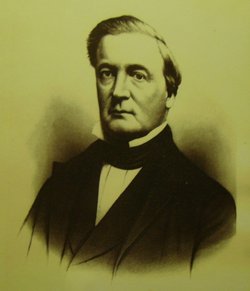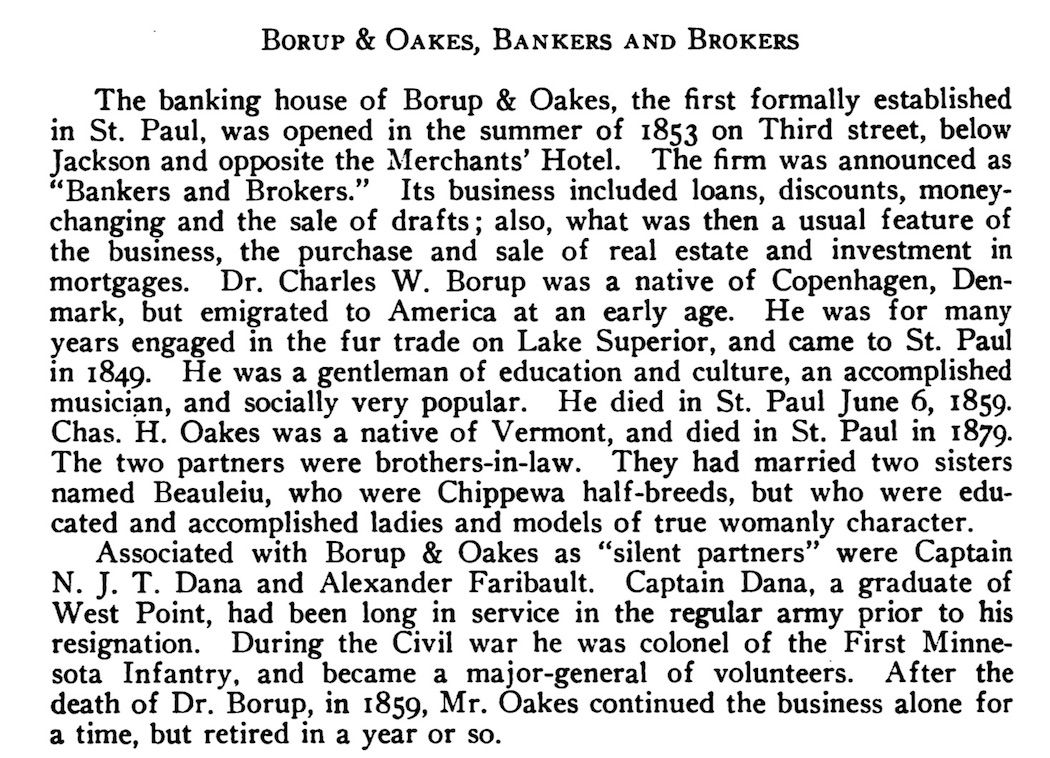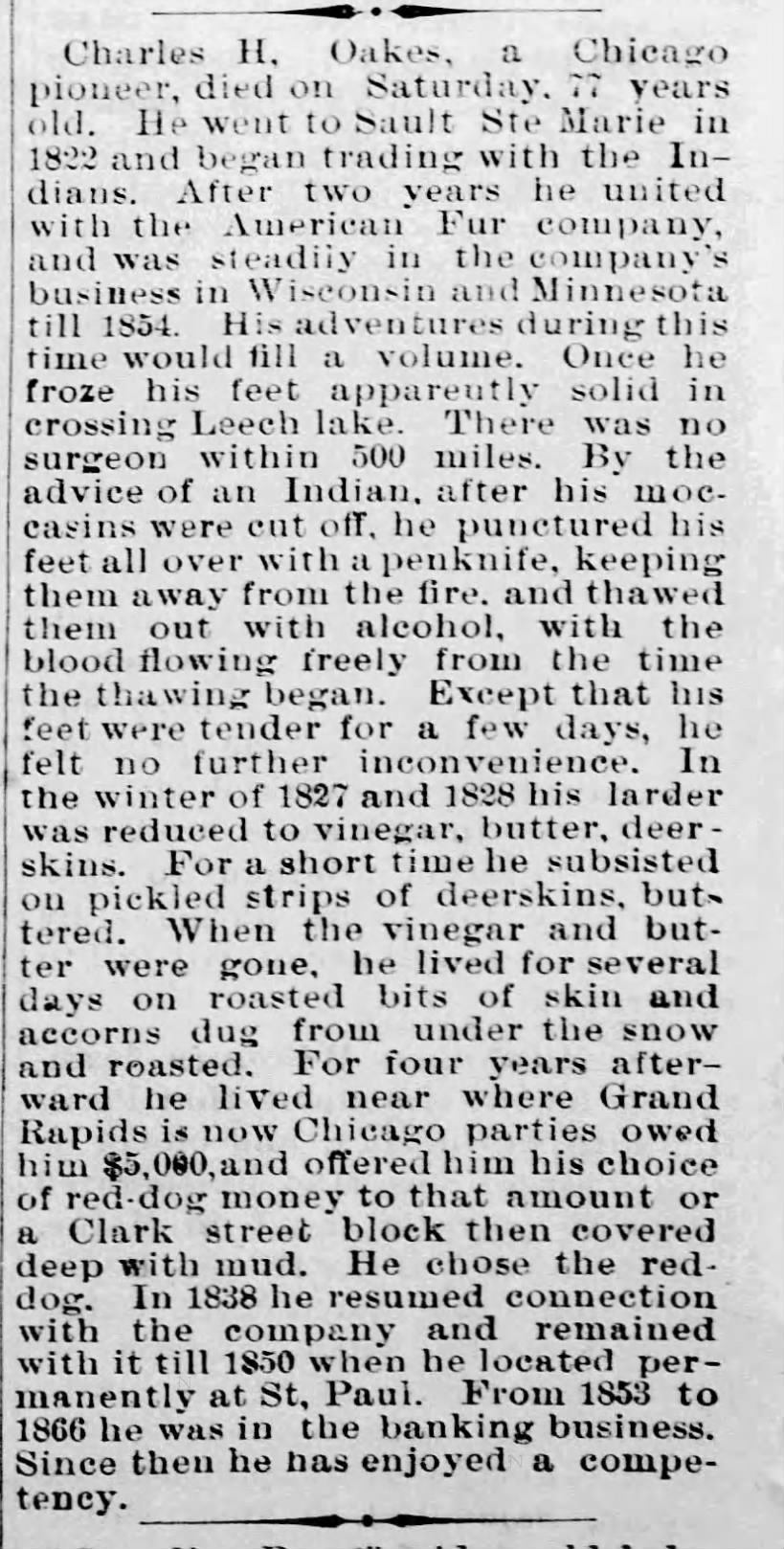Children from 1st marriage: Lt. David O. Oakes, Sophia Russell, Eliza Hughes Sweet; children of 2nd marriage: Geo. Henry Oakes, Charles W. Oakes, Julia Jane VanEtten. Charles H. Oakes died at St. Paul in 1879. Sons: David and Henry were Union soldiers. David Oakes died in battle in 1862..
David O. Oakes was born at La Pointe (in present-day Ashland County), Wisconsin, in 1828, the son of Charles Henry Oakes (a fur trader with the American Fur Company) and Tee-Qua-Shaw. Charles had been born July 17, 1803, in Rockingham, Vermont. Charles and Tee-Qua-Shaw had three children: Sophia (born about 1824), Eliza (born September 3, 1825), and David. Tee-Qua-Shaw died some time between 1828 and 1831. Charles then married Julia R. Beaulieu (born in 1812 in Lac Du Flambeau, Wisconsin) on July 29, 1831. Charles and Julia also had three children: George Henry (born 1833 in Lac Du Flambeau, Wisconsin), Jane E. (born January 24, 1841), and Charles William (born about 1846).
The 1850 census shows Chas. as a 46-year-old Merchant living in La Pointe County, Wisconsin. Living with him are his wife, Julia R. (age 36), son David O. (Clerk, age 20), daughter Jane J. E. (age 9), and son Chas W. (age 4). In 1850, the Oakes family moved to St. Paul, Ramsey County, Minnesota.
www.usgwarchives.org/mn/ramsey/queries/q1st1998.htm - Similarto 1998 queries
City of St Paul Incorporated 1854
In January the legislature (the Fifth territorial) assembled in the new capitol building for the first time. Ramsey county was represented by William P. Murray and Isaac Van Etten, in the council ; and William Noot, William A. Davis, Louis Bartlett, John H. Day and Levi Sloan, in the house.
Among the enactments of the session was a law approved March 3rd which incorporated
"Minnesota Royal Arch Chapter No. 1," of Free Masons, with A. T. C. Pierson, high priest ; Andrew G. Chatfield, king; George L. Becker, scribe; William H. Newton, Henry Morris, George W. Biddle, and James Y. Caldwell, trustees.
Another, approved March 4th chartered the St. Paul Bridge Company, with the following incorporators : Lyman Dayton, J. C. Ramsey, John R. Irvine, J. W. Bass, W. G. Le Due, W. R. Marshall, Joseph R. Brown, George L. Becker, William Ames, N. Myrick, A. L. Larpenteur, J. W. Simpson, C. H. Oakes, M. E. Ames and Louis Robert.
The rude forefathers of the hamlet were taken in hand by men of high ideals and masterly aims. They were guided and molded by Sibley and Rice and Kittson and Oakes and Borup and Steele and Forbes, who assumed the leadership. Their uncouth manners were smoothed out; their repellant proclivities were suppressed; their latent energies were directed into productive channels. The voyageurs and trappers and discharged soldiers were Americanized, and their descendants, including many with visible traces of a part Indian ancestry, are now among St. Paul's worthiest and most respected citizens.
http://www.archive.org/stream/historyofstpaulv01cast/historyofstpaulv01cast_djvu.txt
Children from 1st marriage: Lt. David O. Oakes, Sophia Russell, Eliza Hughes Sweet; children of 2nd marriage: Geo. Henry Oakes, Charles W. Oakes, Julia Jane VanEtten. Charles H. Oakes died at St. Paul in 1879. Sons: David and Henry were Union soldiers. David Oakes died in battle in 1862..
David O. Oakes was born at La Pointe (in present-day Ashland County), Wisconsin, in 1828, the son of Charles Henry Oakes (a fur trader with the American Fur Company) and Tee-Qua-Shaw. Charles had been born July 17, 1803, in Rockingham, Vermont. Charles and Tee-Qua-Shaw had three children: Sophia (born about 1824), Eliza (born September 3, 1825), and David. Tee-Qua-Shaw died some time between 1828 and 1831. Charles then married Julia R. Beaulieu (born in 1812 in Lac Du Flambeau, Wisconsin) on July 29, 1831. Charles and Julia also had three children: George Henry (born 1833 in Lac Du Flambeau, Wisconsin), Jane E. (born January 24, 1841), and Charles William (born about 1846).
The 1850 census shows Chas. as a 46-year-old Merchant living in La Pointe County, Wisconsin. Living with him are his wife, Julia R. (age 36), son David O. (Clerk, age 20), daughter Jane J. E. (age 9), and son Chas W. (age 4). In 1850, the Oakes family moved to St. Paul, Ramsey County, Minnesota.
www.usgwarchives.org/mn/ramsey/queries/q1st1998.htm - Similarto 1998 queries
City of St Paul Incorporated 1854
In January the legislature (the Fifth territorial) assembled in the new capitol building for the first time. Ramsey county was represented by William P. Murray and Isaac Van Etten, in the council ; and William Noot, William A. Davis, Louis Bartlett, John H. Day and Levi Sloan, in the house.
Among the enactments of the session was a law approved March 3rd which incorporated
"Minnesota Royal Arch Chapter No. 1," of Free Masons, with A. T. C. Pierson, high priest ; Andrew G. Chatfield, king; George L. Becker, scribe; William H. Newton, Henry Morris, George W. Biddle, and James Y. Caldwell, trustees.
Another, approved March 4th chartered the St. Paul Bridge Company, with the following incorporators : Lyman Dayton, J. C. Ramsey, John R. Irvine, J. W. Bass, W. G. Le Due, W. R. Marshall, Joseph R. Brown, George L. Becker, William Ames, N. Myrick, A. L. Larpenteur, J. W. Simpson, C. H. Oakes, M. E. Ames and Louis Robert.
The rude forefathers of the hamlet were taken in hand by men of high ideals and masterly aims. They were guided and molded by Sibley and Rice and Kittson and Oakes and Borup and Steele and Forbes, who assumed the leadership. Their uncouth manners were smoothed out; their repellant proclivities were suppressed; their latent energies were directed into productive channels. The voyageurs and trappers and discharged soldiers were Americanized, and their descendants, including many with visible traces of a part Indian ancestry, are now among St. Paul's worthiest and most respected citizens.
http://www.archive.org/stream/historyofstpaulv01cast/historyofstpaulv01cast_djvu.txt
Family Members
Advertisement
Advertisement












